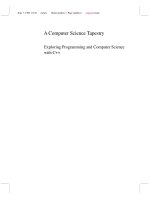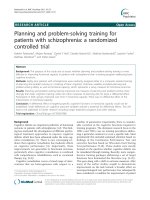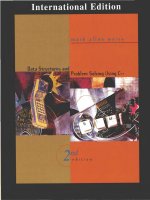programming and problem solving with c++ 6th by dale ch10
Bạn đang xem bản rút gọn của tài liệu. Xem và tải ngay bản đầy đủ của tài liệu tại đây (722.23 KB, 93 trang )
Chapter 10
Simple Data Types:
Built-In and UserDefined
Chapter 10 Topics
External and Internal Representations of Data
Integral and Floating Point Data Types
Using Combined Assignment Operators
Using an Enumeration Type
Chapter 10 Topics
Creating and Including User-Written Header
Files
Meaning of a Structured Data Type
Declaring and Using a struct Data Type
C++ union Data Type
C++ Pointer & Reference Types
C++ Simple Data Types
simple types
floating
integral
char
short
int
unsigned
long
bool
enum
float
double
long double
By definition,
The size of a C++ char value is always 1 byte
‘A’
exactly one byte of memory space
Sizes of other data type values in C++ are
machine-dependent
Using one byte (= 8 bits)
0
1
1
0
0
0
1
1
How many different numbers can be represented
using 0’s and 1’s?
Each bit can hold either a 0 or a 1. So there are just two
choices for each bit, and there are 8 bits.
2 x 2 x 2 x 2 x 2 x 2 x 2 x 2 = 28 = 256
Using two bytes (= 16 bits)
0
1
1
0
0
0
1
1
0
1
0
0
1
0
1
216 = 65,536
So 65, 636 different numbers can be represented
If we wish to have only one number representing
the integer zero, and half of the remaining
numbers positive, and half negative, we can obtain
the 65,536 numbers in the range -32,768 . . . . 0 . . . .
32,767
0
Some Integral Types
Type
Size in Bytes
Minimum Value
Maximum Value
char
1
-128
127
short
2
-32,768
32,767
int
2
-32,768
32,767
long
4
-2,147,483,648
2,147,483,647
NOTE: Values given for one machine; actual sizes are machine-dependent
Data Type bool
Domain contains only 2 values, true and
false
Allowable operation are the logical (!, &&,
||) and relational operations
Operator sizeof
sizeof A C++ unary operator that yields the size on
your machine, in bytes, of its single operand. The
operand can be a variable name, or it can be the name
of a data type enclosed in parentheses.
int age;
cout << “Size in bytes of variable age is “
<< sizeof age << end;
cout << “Size in bytes of type float is “
<< sizeof (float) << endl;
The only guarantees made by
C++ are . . .
1 = sizeof(char) <= sizeof(short) <= sizeof(int) <=
sizeof(long)
1 <= sizeof (bool) <= sizeof (long)
sizeof (float) <= sizeof (double) <= sizeof (long double)
. . . and the following three other
C++ guarantees
char is at least 8 bits
short is at least 16 bits
long is at least 32 bits
Exponential (Scientific) Notation
2.7E4 means 2.7 x 10 4 =
2.7000
=
27000.0
2.7E-4 means 2.7 x 10 - 4 =
0002.7
0.00027
=
Floating Point Types
Type
Size in Bytes
float
double
long double
Minimum
Positive Value
Maximum
Positive Value
4
3.4E-38
3.4E+38
8
1.7E-308
1.7E+308
10
3.4E-4932
1.1E+4932
NOTE: Values given for one machine; actual sizes are machine-dependent
More about Floating Point Types
Floating point constants in C++ like 94.6
without a suffix are of type double by
default
To obtain another floating point type
constant a suffix must be used
The suffix F or f denotes float type, as in 94.6F
The suffix L or l denotes long double, as in
94.6L
Header Files
climits and cfloat
Contain constants whose values are the
maximum and minimum for your
machine
Such constants are FLT_MAX, FLT_MIN,
LONG_MAX, LONG_MIN
Header Files climits and
cfloat
#include <climits>
using namespace std;
cout << “Maximum long is “ << LONG_MAX
<< endl;
cout << “Minimum long is “ << LONG_MIN
<< endl;
C++ Data Types
simple
integral
enum
structured
floating
array struct union class
char short int long bool
float double long double
address
pointer
reference
ASCII and EBCDIC
ASCII (pronounced ask-key) and EBCDIC are two character
sets commonly used to represent characters internally as
one-byte integers
ASCII is used on most personal computers; EBCDIC is used
mainly on IBM mainframes
The character ‘A’ is internally stored as integer 65 in ASCII
and 193 in EBCDIC
In both sets, uppercase and lowercase letters are in
alphabetical order, allowing character comparisons such as
‘A’ < ‘B’, ‘a’ < ‘b’...
ASCII is a subset of Unicode, a character set that uses two
bytes to represent each character and has a wider
international following than ASCII
Right
Digit
Left
Digit(s)
ASCII (Printable) Character Set
0
1
2
3
”
!
3
)
*
4
5
“
+
6
#
,
7
8
9
%
&
‘
$
4
(
-
.
/
0
1
5
2
3
4
5
6
7
8
9
:
;
6
<
=
>
?
@
A
B
C
D
E
7
F
G
H
I
J
K
L
M
N
O
8
P
Q
R
S
T
U
V
W
X
Y
9
Z
[
\
]
^
_
`
a
b
c
10
d
e
f
g
h
I
j
k
l
m
11
n
o
p
q
r
s
t
u
v
w
12
x
y
z
{
|
}
~
C++ Data Types
simple
integral
enum
structured
array struct union class
floating
char short int long bool
float double long double
address
pointer
reference
typedef statement
typedef creates an additional name for an
already existing data type
Before bool type became part of ISO-ANSI
C++, a Boolean type was simulated this way
on the following slide
typedef statement
typedef int Boolean;
const Boolean true = 1;
const Boolean false = 0;
:
Boolean dataOK;
:
dataOK = true;
Combined Assignment Operators
int age;
cin >> age;
A statement to add 3 to age
age = age + 3;
OR
age += 3;
A statement to subtract 10 from weight
int weight;
cin >> weight;
weight = weight 10;
OR
weight = 10;









